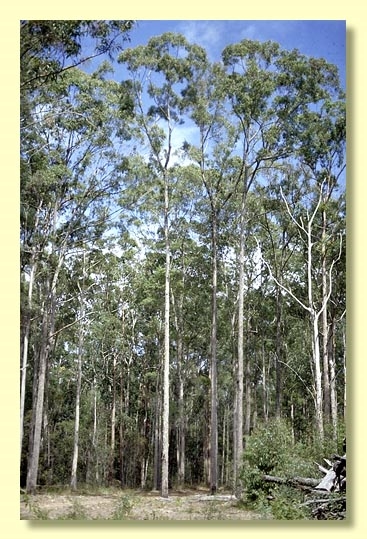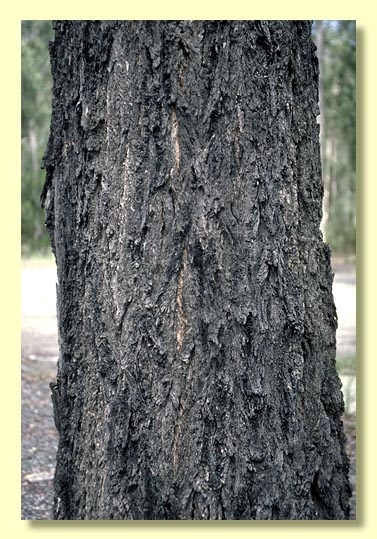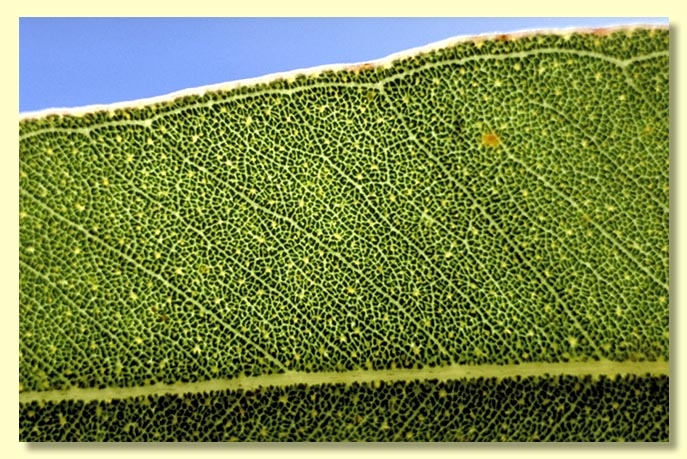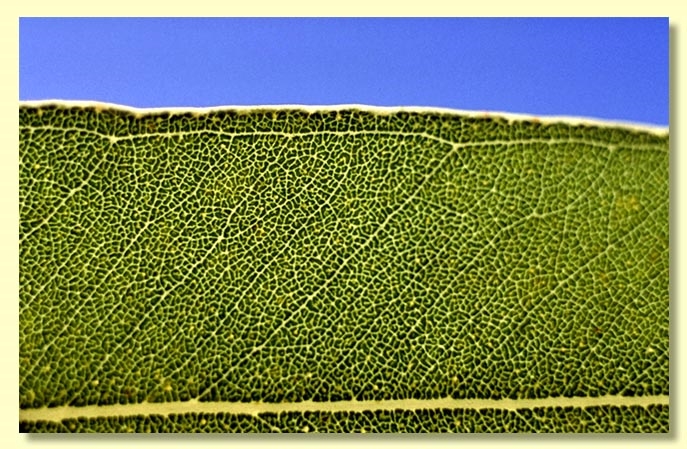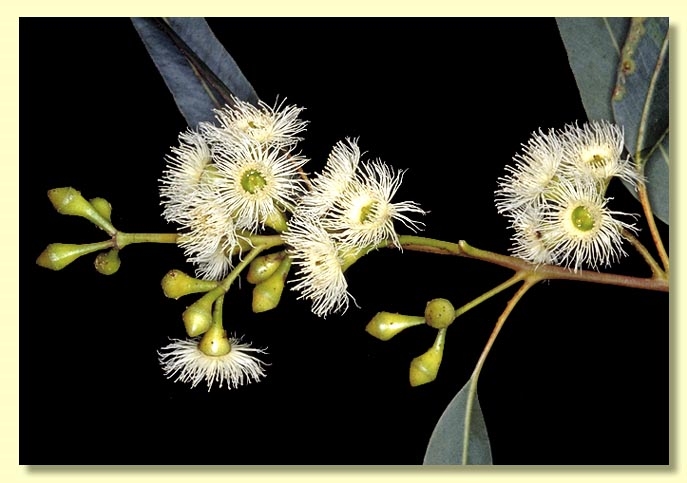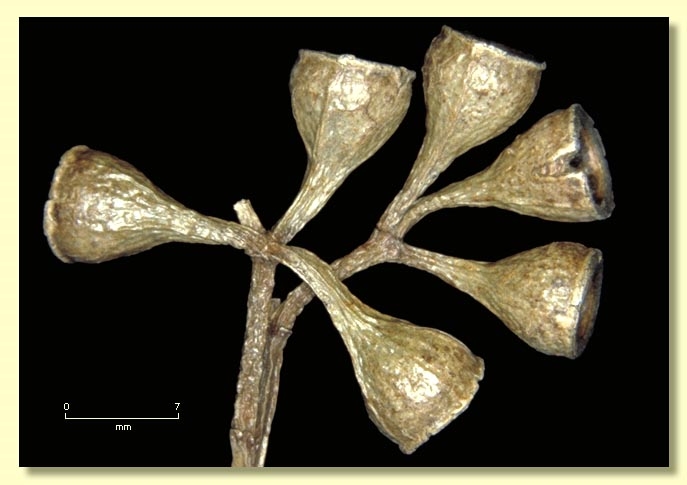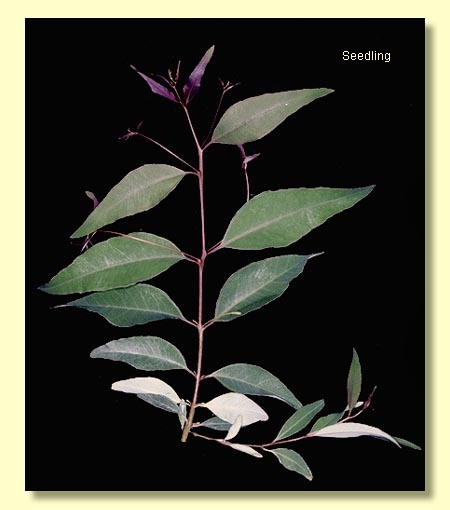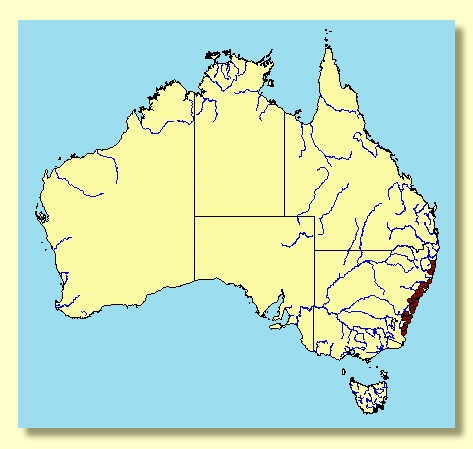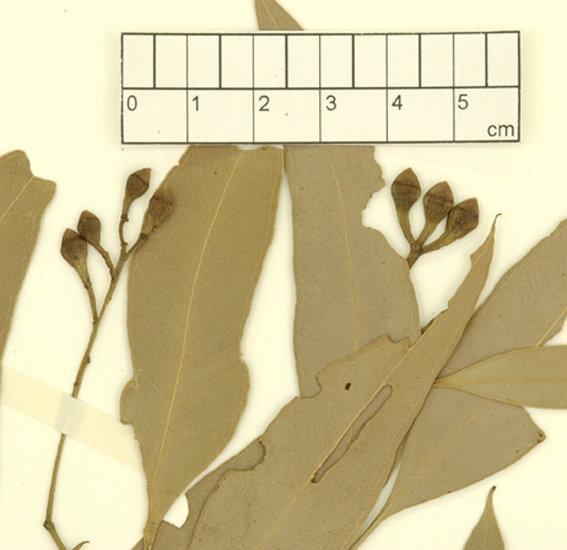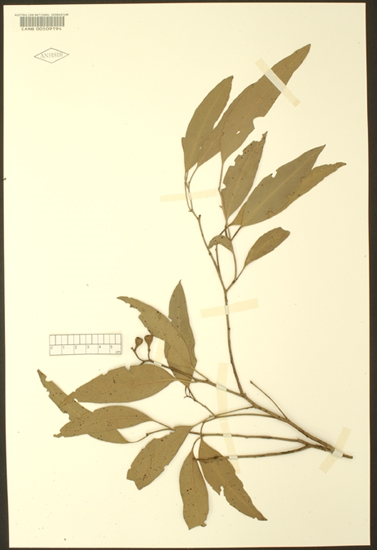Euclid - Online edition
Eucalyptus paniculata
Eucalyptus | Symphyomyrtus | Adnataria | Terminales | Rhodoxylon | Discolores
T: Port Jackson, NSW, D.Burton s.n.; holo: LINN; iso: BM.
Eucalyptus nanglei R.T.Baker, J. & Proc. Roy. Soc. New South Wales 51: 418 (1917). T: Woy Woy, Lindfield, Nowra, Morisset, Stroud, Bulahdelah, NSW, collectors unknown; herbarium holding these syntypes unknown to us.
Eucalyptus fergusonii R.T.Baker subsp fergusonii, J. & Proc. Roy. Soc. New South Wales 51: 415 (1917). T: Bulahdelah, N.S.W., Oct. 1916, L.C.Maxwell; lecto NSW; fide J.H.Maiden, Crit. Revis. Eucalyptus 5: 259 (1921).
Eucalyptus paniculata Sm. subsp. matutina L.A.S.Johnson & K.D.Hill, Telopea 4: 77 (1990). T: NSW, North Coast, Tomaree Headland, towards top of ridge to east of hospital, 3 May 1984, K.D.Hill 759 & L.A.S.Johnson; holo: NSW; iso: BRI, CANB, MEL.
Ironbark to small branches, grey to black or brownish, hard and deeply furrowed longitudinally.
Juvenile growth (coppice or field seedlings to 50 cm): stem square in cross-section; juvenile leaves always petiolate, opposite for about 6 pairs then alternate, ovate to lanceolate, 3.5–7 cm long, 1.5–3 cm wide, discolorous, green.
Adult leaves alternate, petiole 0.9–2.5 cm long; blade lanceolate to falcate, 5–18 cm long, 1.2–3 cm wide, base tapering to petiole, discolorous, glossy, green, side-veins greater than 45° to midrib, densely to very densely reticulate, intramarginal vein parallel to and just within margin, oil glands intersectional or obscure.
Inflorescence terminal compound and sometimes unbranched in subterminal axils also, peduncles 0.5–1.5 cm long, buds 7 per umbel, pedicels 0.3–0.9 cm long. Mature buds ovoid to diamond-shaped, base of hypanthium more or less square in cross-section, 0.5–0.9 cm long, 0.4–0.5 cm wide, green to yellow, scar present, operculum conical, stamens inflexed, with outer staminodes, anthers adnate, positioned obliquely at filament tip, cuboid, dehiscing by terminal pores, style long, stigma pin-head shaped, locules 4 or 5, the placentae each with 4 vertical ovule rows. Flowers white.
Fruit on pedicels 0.2–1 cm long, obconical, hemispherical or cup-shaped, sometimes almost square in cross section, 0.4–0.8 cm long, 0.4–0.8 cm wide, often weakly ribbed longitudinally, disc descending but frequently obscured by persistent broad staminophore, valves 4 or 5, near rim level or enclosed.
Seeds brown, 1.5–2 mm long, flattened-ovoid, dorsal surface shallowly reticulate, hilum ventral.
Cultivated seedlings (measured at ca node 10): cotyledons reniform to oblong; stems square in cross-section; leaves always petiolate, opposite for ca 5–7 nodes then alternate, ovate, 4.5–7 cm long, 2–4.5 cm wide, base tapering to rounded, margin entire, apex pointed, dull, green.
Flowering has been recorded in all months except March.
A small to tall forest ironbark tree of coastal plains and hills from Bermagui north to Buladelah in New South Wales. Characterised by the combination of distinctly discolorous glossy green adult leaves, terminal inflorescences, buds with inflexed stamens with an outer whorl of staminodes, fruit with four or five valves and ovate juveniles.
Eucalyptus paniculata is closely related to E. placita, E. decolor and E. sp. Dorsiventralis, all four species having distinctly discolorous adult leaves and belonging to the subseries Discolores. Within this group, E. paniculata is only weakly separated from E. placita. E. placita differs by having slightly broader, very glossy green juveniles leaves (up to 6 cm wide in E. placita and up to 4.5 cm wide in E. paniculata). E. decolor differs only slightly by having dull green adult leaves (glossy in E. paniculata) and E. sp. Dorsiventralis differs by having slightly larger buds and fruit, with buds and fruit distinctly four-sided (buds and fruit in E. paniculata sometimes weakly four-side, fruit in E. sp. Dorsiventralis 0.6–1 cm wide and 0.5–0.8 cm in E. paniculata).
Within its area of occurrence there are three other closely related ironbark species that share the stamen characteristics of E. paniculata (i.e. stamens regularly inflexed with an outer whorl of staminodes).
They are E. fusiformis, which has dull, concolorous leaves and more delicate, smaller buds and fruit; the rare E. tetrapleura, also with dull concolorous leaves but with fruit prominently ribbed and square in cross-section; and E. beyeri, which is normally of more inland distribution but which does come near the coast south of Sydney in the Nowra–Yalwal–Mittagong area and which differs by having dull green to grey-green adult leaves and much smaller buds and fruit.
Three other ironbark species also found within the range of E. paniculata are E. fibrosa, E. ophitica and E. siderophloia, all of which differ in having concolorous leaves and buds with stamens all fertile and irregularly flexed.
Eucalyptus sideroxylon, of more inland distribution than E. paniculata, also differs by having concolorous dull adult leaves and by having buds that hold the outer operculum into maturity and both the inner and outer operculum shed together at anthesis (no operculum scar).
Eucalyptus paniculata subsp. matutina was distinguished from typical E. paniculata because the adult leaves are weakly amphistomatic (i.e. have stomata on both surfaces rather than just the lower side). In EUCLID we do not uphold this distinction at subspecies level.
MORE ABOUT IRONBARKS

